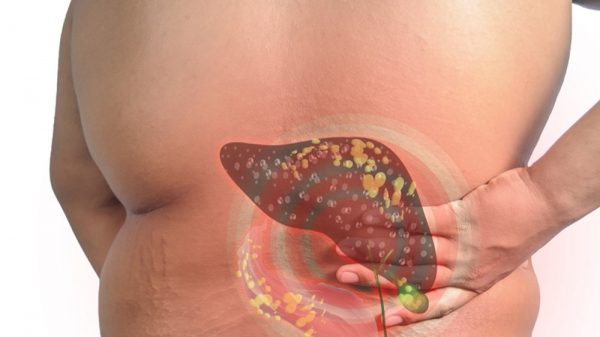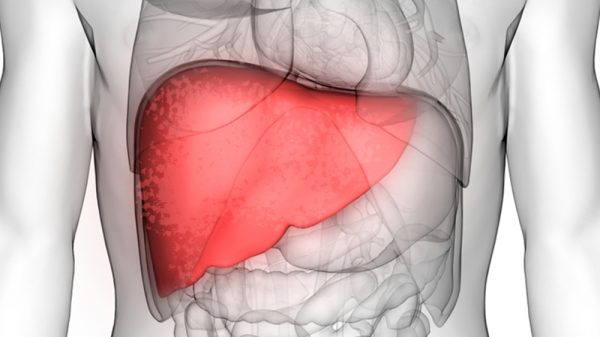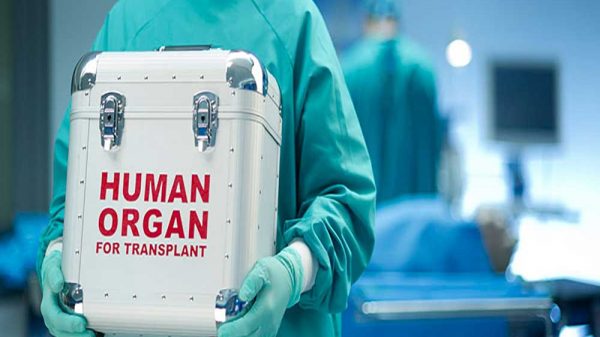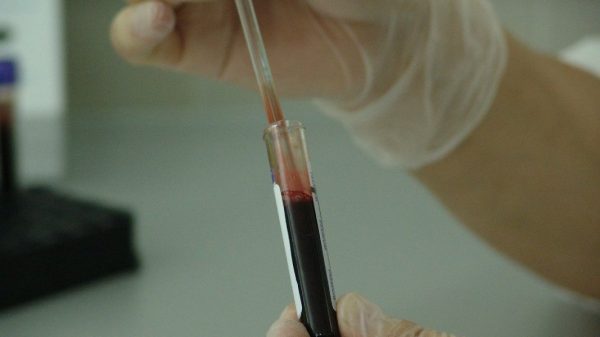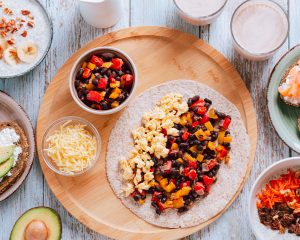Getting enough protein is a vital part of the fatty liver disease diet plan. But why is protein so important and how can you make sure that you’re getting the protein that you need? If you’re wondering about the benefits of protein for fatty liver disease and how to get more protein in your diet, then you’ve come to the right place. In this article, we go through the answers to all of your questions.
Why Is Protein an Important Part of the Fatty Liver Disease Diet Plan?
Dietary protein is a crucial part of the human diet because it offers amino acids. Amino acids are the building blocks of protein, and both nonessential and essential amino acids are important for health. The key difference between these two types of amino acids is that the body is able to manufacture nonessential amino acids when needed. On the other hand, essential amino acids must be obtained in balanced ratios from dietary sources, in order to support optimal biological function.
Essential amino acids are indispensable for human health. The body utilizes essential amino acids for nearly all biological processes and mechanisms. For example, essential amino acids are required to produce muscle tissue, connective tissue, neurotransmitters, and hormones. Getting optimal ratios of essential amino acids is important for supporting immune system health, metabolic function, and liver health.
The essential amino acids found in protein play a particularly crucial role in supporting liver health. So, why are essential amino acids so important for liver health, and how do they protect against fatty liver disease? Research reveals the pivotal role of essential amino acids in promoting liver health.
In a study published in Nutrition, researchers found that essential amino acid supplementation in a sample of 12 elderly adults was linked to decreased liver fat levels, in comparison to the control trial. (1) In another study published in the International Journal of Immunopathology and Pharmacology, researchers found that supplementation with essential amino acids helps combat alcohol-induced liver damage in rat models. (2)
Moreover, evidence shows that three of the essential amino acids -leucine, isoleucine, and valine -have potentially therapeutic effects on liver disease. Research published in Translational Gastroenterology and Hepatology highlights how these branched-chain amino acids have a protective effect on the liver by supporting healthy liver cell proliferation and impeding the development of liver cancer. (3)
Getting optimal ratios of essential amino acids on a daily basis can help fight against muscle wasting by making it easier to build muscle. Maintaining muscle mass helps fight against the symptoms of more serious liver diseases like cirrhosis, and helps improve health outcomes for these conditions. Getting too little protein can lead to health issues, with serious protein deficiency symptoms presenting as liver dysfunction, immune system dysfunction, and muscle wasting.
Does Protein Give You Energy?
Protein offers lots of health benefits, with one of those benefits being sustainable energy. Unlike carbohydrates, protein is digested more slowly and provides energy throughout the day. Protein also helps keep blood sugar levels steady. Carbohydrates, on the other hand, are digested more rapidly and serve as a more immediate energy source.
Tips for How to Get More Protein on the Fatty Liver Disease Diet Plan
If you’re worried you may not be getting enough protein and optimal ratios of essential amino acids, try out the following tips.
1. Choose Minimally Processed Meat and Dairy Products That Are Low in Fat
Animal products like meat and dairy are excellent sources of protein. All animal sources of protein are complete proteins, because they offer optimal ratios of essential amino acids. The one caveat when it comes to animal protein is the saturated fat it contains. A high saturated fat consumption over time is linked to high cholesterol levels, insulin resistance, type 2 diabetes, weight gain, fatty liver disease, and heart disease.
To make sure your protein sources are heart-healthy and support optimal metabolic function, choose minimally processed meat and dairy products that are also low in fat. For example, choose lean cuts of grass-fed organic beef, chicken breast, nonfat Greek yogurt, and skim milk. Steer clear of foods like fatty cuts of steak, bacon, dark meat chicken, whole milk, and butter.
2. Eat Fatty Fish Weekly
Fatty fish is part of a healthy eating regimen that supplies high-quality protein and fights against fatty liver disease. Fatty fish like salmon, mackerel, arctic char, and sardines are rich in protein and also offer omega-3 fatty acids. These healthy fats help lower systemic inflammation and may help improve metabolic function and fight against liver inflammation.
3. Keep High-Quality Protein Supplements on Hand
High-quality supplements can help you ensure that you’re getting the protein and essential amino acids you need daily. Supplementing can be especially helpful if you’re following a plant-based diet or have a restricted diet due to other health reasons, such as gastrointestinal issues. Whey protein, casein protein, and essential amino acid supplements are examples of excellent protein supplement options.
Essential amino acid supplements are very low in calories and offer essential amino acids in their individual form. This is often ideal for older adults whose digestive systems may not work efficiently and cannot effectively break down whole protein particles.
4. Consume a Variety of Vegetable Proteins
Are you wondering how to get more protein without meat? Though it’s very doable to get plenty of protein from vegetable sources, it is more challenging to obtain the right amounts of essential amino acids from plant protein. Unlike animal protein, any single vegetable protein source does not offer optimal ratios of essential amino acids. As a result, it’s important to consume a variety of vegetable proteins throughout the day, especially if you follow a plant-based or vegan diet. Whole grains, nuts, seeds, beans, and soy products are excellent sources of plant-based proteins.
5. Incorporate Protein into Every Meal
Making protein a part of every meal helps ensure that you’re getting the protein and essential amino acids that your body needs. Moreover, consuming protein at every meal helps regulate digestion and stabilize blood sugar levels. Because protein is digested more slowly, it can help you stay fuller for longer. As a result, this helps moderate appetite levels and can help support a healthy body weight.
High-Protein Meal Ideas
Not sure how to transform the above tips into everyday use? We’ve got you covered with meal ideas incorporating the tips from the above section.
Scrambled Eggs with Avocado Toast
If you enjoy a hearty breakfast, try this meal of avocado toast and scrambled eggs. Prepare your avocado toast by mashing ripe avocado onto a slice of whole-grain toast. Add a few crumbles of low-fat feta cheese and top with salt, pepper, red pepper flakes, lime juice, and cilantro.
Next, prepare your scrambled eggs using three egg whites, one egg yolk, and a splash of skim milk. Egg whites are packed with protein, while also being low in calories and saturated fat. Whisk the egg mixture in a bowl and season with salt, pepper, and red pepper flakes. Pour the eggs into a heated, nonstick pan. As the eggs cook, move them around with a spatula. For extra veggies, add chopped spinach to your scrambled eggs. Serve with avocado toast and enjoy.
Cottage Cheese with Granola and Fresh Fruit
Cottage cheese is a great option for a light breakfast that offers lots of high-quality protein. It’s also easy to prepare. First, add a serving of cottage cheese to a bowl. Top the cottage cheese with low-sugar granola, fresh berries, pumpkin seeds, and a drizzle of honey.
Chia Seed Pudding
This vegan breakfast option is a great way to get tons of fiber and protein. Add whole chia seeds to a bowl along with your favorite plant-based milk, such as coconut milk or almond milk. Allow the mixture to soak overnight. Allow the chia seed mixture to soak in the refrigerator overnight. In the morning, the pudding will be ready to enjoy. Top the pudding with chopped dates, sliced bananas, blueberries, and crushed walnuts.
Overnight Oats
Like chia seed pudding, overnight oats can be prepared the night before. Add a serving of oats to a jar, along with ground flaxseeds, cinnamon, and soy milk. Allow the oats to sit in the refrigerator overnight. The next morning, top the oats with sliced bananas for potassium, pumpkin seeds for healthy fats and magnesium, blueberries for antioxidants, and chopped dates for extra sweetness. If desired, add a dollop of your favorite nut butter, like peanut butter or almond butter.
Tacos with Veggies and Ground Beef
This dinner idea is delicious and nutrient-packed. First, prepare the filling by sauteing lean ground beef in a pan with chipotle chili powder, garlic powder, cumin, paprika, salt, and pepper. Next, prepare the vegetables by sauteing onions, peppers, red cabbage, mushrooms, and spinach in a pan with the same seasonings. Assemble your tacos by layering the beef and veggies in whole-grain taco shells. Top the tacos with chopped cilantro, guacamole, salsa, and a squeeze of lime.
Chicken and Vegetable Stir-Fry
This tasty dish offers both lots of protein and veggies, supplying optimal ratios of essential amino acids and antioxidants to fight fatty liver disease. First, saute sliced chicken breast in a pan with a little bit of olive oil, salt, and pepper. Heat the chicken breast in the pan until it is cooked through. Next, add a variety of veggies and beans like onions, bell peppers, carrots, mushrooms, broccoli, cauliflower, black beans, kidney beans, and spinach. Season your stir-fry with curry powder, chopped ginger, chopped garlic, turmeric, and a dash of salt and pepper. Pour light coconut milk into the pan and allow the dish to gently simmer. Enjoy as is or serve over a whole-grain, such as brown rice.
Protein Shake
Protein shakes and smoothies are great options for meeting your protein needs. Plus, protein shakes are easy to prepare and versatile. They can be enjoyed any time of the day, from post-workout refueling to meal replacements. Here are a few protein shake ideas that offer optimal ratios of essential amino acids.
- Mango mixer: Add frozen mango, frozen banana, pineapple, essential amino acid powder, ice cubes, and almond milk to a blender. Blend until smooth.
- Green machine: Add fresh spinach, baby kale, lime juice, chopped ginger, a sliced apple, ice cubes, and water to a blender along with essential amino acid powder. Blend until smooth.
- Peanut butter chocolate shake: Add frozen bananas, pure cacao powder, oats, chocolate protein powder, and ground flaxseeds to a blender. Add soymilk or skim milk and blend until smooth.
Pasta with Meatballs
Who said pasta with meatballs has to be unhealthy? Try this healthy, high-protein version of spaghetti and meatballs. First, to increase the fiber and protein content of your dish, choose spaghetti made with chickpeas or lentils. Prepare meatballs using lean ground turkey, whole-wheat breadcrumbs, fresh herbs like basil, salt, and pepper. Bake the meatballs in the oven until they are cooked through.
Toss the pasta and meatballs with your favorite marinara sauce. Sprinkle with parmesan cheese.
Green Salad with Baked Salmon
Large salad topped with baked salmon and a variety of veggies and legumes is a great way to get a balance of macronutrients and micronutrients to support healthy liver function. First, chop kale, arugula, and spinach into bite-size pieces. Mix in tomatoes, onions, roasted red peppers, white beans, edamame, and quinoa. Next, prepare a salmon fillet by seasoning it with salt, pepper, lemon, and red pepper flakes and baking it in the oven until just cooked. Place on top of your salad and enjoy.
Mediterranean Wrap with Falafel and Low-Fat Cheese
This vegetarian wrap is packed with protein and fiber for a hearty breakfast or lunch option. First, spread hummus on a whole-grain pita wrap. Add falafel, spinach, baby kale, tomatoes, red onions, and low-fat feta cheese to the wrap. Season with salt, pepper, red pepper flakes, and lemon juice.
Smoothie Bowl
A smoothie bowl is a tasty, protein-packed breakfast. Prepare your smoothie by adding frozen bananas, strawberries, blueberries, and mango to a blender with your favorite dairy-free milk such as almond milk or soy milk. The trick to making a smoothie bowl is adding only a small amount of milk, to ensure that the smoothie is thick enough to eat with a spoon. Add your favorite essential amino acid powder and blend until smooth.
Use a large spoon and scoop your smoothie into a bowl. Add a variety of toppings like pecans, shredded coconut, hemp seeds, and oats.
Protein Pancakes
Protein pancakes are an easy and delicious way to incorporate lots of protein into your morning meal. Plus, you can prepare protein pancakes in bulk and simply store them in the refrigerator or the freezer, reheating them when you want to enjoy them. To make protein pancakes, mix together mashed bananas, ground flaxseeds, eggs, protein powder, almond flour, whole-wheat flour, and soy milk. Prepare the pancakes using a griddle and serve them with fresh fruit, crushed pecans, and a drizzle of maple syrup.
Conclusion: How to Get More Protein on the Fatty Liver Disease Diet Plan
Protein is a vital part of the fatty liver disease diet plan, because the body requires essential amino acids to support optimal liver health. Choosing low-fat meat and dairy, fatty fish, a variety of veggie proteins, and using high-quality supplements can help you incorporate more protein into your daily routine.
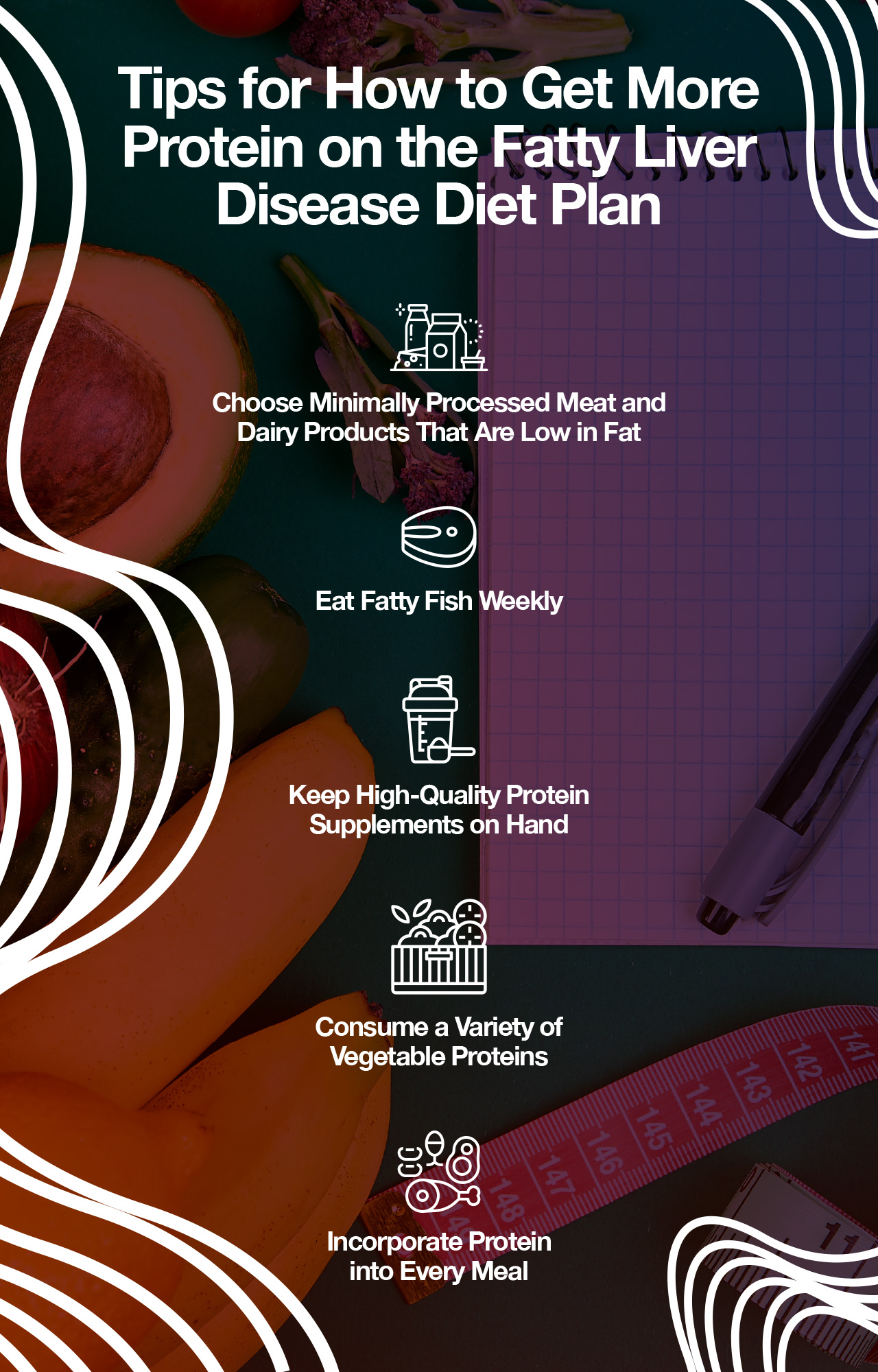
References:
(1) https://www.ncbi.nlm.nih.gov/pmc/articles/PMC2696073/
(2) https://journals.sagepub.com/doi/pdf/10.1177/039463201102400307
